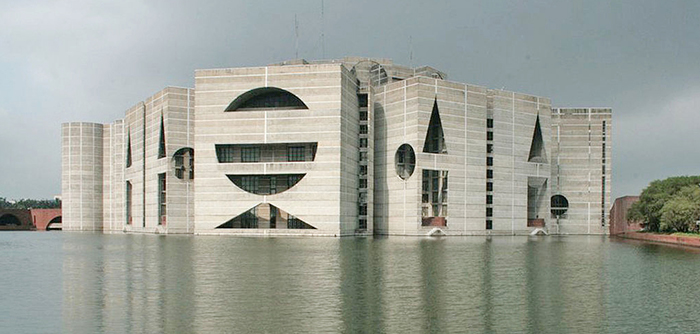Book will tell story of Pakistan, Bangladesh through architecture

LAWRENCE — If it’s not quite a “secret history,” then Farhan Karim’s latest project is at least an overview of an overlooked phenomenon in an important region of the world.
 An assistant professor in the University of Kansas School of Architecture & Design, the Bangladesh native has received a Mellon-Volkswagen Fellowship to complete the writing of a book on the history of architecture in the nascent state of Pakistan. The fellowship is funded jointly by the Andrew W. Mellon Foundation and the Volkswagen Foundation.
An assistant professor in the University of Kansas School of Architecture & Design, the Bangladesh native has received a Mellon-Volkswagen Fellowship to complete the writing of a book on the history of architecture in the nascent state of Pakistan. The fellowship is funded jointly by the Andrew W. Mellon Foundation and the Volkswagen Foundation.
“I am looking at the history of post-colonial Pakistan; from 1947 to 1971,” Karim said. “This is a time that has special significance in world history. Pakistan was created as a utopia. East and West Pakistan were combined together under a theoretical understanding of Muslim nationalism, even though they were 1,000 miles apart and even though East Pakistan, which later became Bangladesh, had different languages and cultural practices.”
When, after almost a century of imperial rule, Britain divested itself of the Indian subcontinent in 1947, it gave rise to two independent and religiously homogenous nations: mostly Hindu India and the two halves of mostly Muslim Pakistan that lay on either side of it.
When East Pakistan broke away in a 1971 liberation war to become Bangladesh, it sparked a secondary conflict between (West) Pakistan and India, the flashpoint of which was and remains the province of Kashmir.
“The bloody war was an embarrassing part of history for scholars who work in Pakistan and Bangladesh,” Karim said. “In scholarly discussions, there is a large gap. I’m an architectural historian, and that is an even much less discussed area.
“I am trying to understand through the lens of architectural history how this construction of a utopian Pakistan was structured through design, and, specifically, through state-sponsored architecture. The capital of Pakistan, Islamabad, was a completely new city, a la Brasilia in Brazil or Chandigarh in India. Groups of designers arrived at that site. They were excited, yet they had a plan. They were standing in the middle of nowhere and asked to build an entire city.”
At the same time, Karim said, Pakistanis had undertaken a “massive educational reform project.” The Brits had been kicked out, and yet Pakistan had not developed a native educational infrastructure. Thus, he said, “When Pakistan was in a total nation-building project, they did not have enough architects, so they partnered with the USA.”
“The United States became a Cold War ally to Pakistan. With grants from the United States Agency for International Development and the Ford Foundation, they went to Pakistan to build that infrastructure.”
Karim said consultants poured in from the United States, Greece, Turkey, Japan and Germany. Perhaps the most famous of them was the American Louis Kahn, who designed the National Parliament House for what was East Pakistan when he received the commission, but which later became Bangladesh. Kahn was invited to design the project in Dhaka by Pakistan’s then-leader, Ayub Khan.
“When it comes to architectural history, we understand Louis Kahn as a lone genius, creating his masterpiece, but he also had a good relationship with USAID,” Karim said. “His take on the Cold War intervention in South Asia needs to be discussed. When discussing architectural history, he saw himself as a representative of the United States, working in South Asia. When we look at how Louis Kahn saw himself, embedded in a larger sociopolitical context, a new story will appear before our eyes.”
Karim said he has been researching the subject for the past five years, poring over records in archives in the United States and Greece, among other places.
“I’ve been to 15 places in the last five years,” he said. “It’s an epic story that needs epic length to tell it.”
Karim has given his book the working title “Dreaming of a Nation.” The Volkswagen-Mellon Fellowship will give him nine to 10 months off from his teaching duties so he can complete his manuscript. He will travel to Berlin to work on the book at the ZMO (Zentrum Moderner Orient, or Center for Modern Oriental Studies) research institute there.
During his previous work, Karim said, “I realized how little we know about the contemporary design history of South Asia.” The book is his attempt to remedy that situation.
Photo: The National Parliament House, or Jatiya Sangsad Bhaban, in Dhaka, Bangladesh, was designed by American Louis Kahn. Image via WikiCommons.